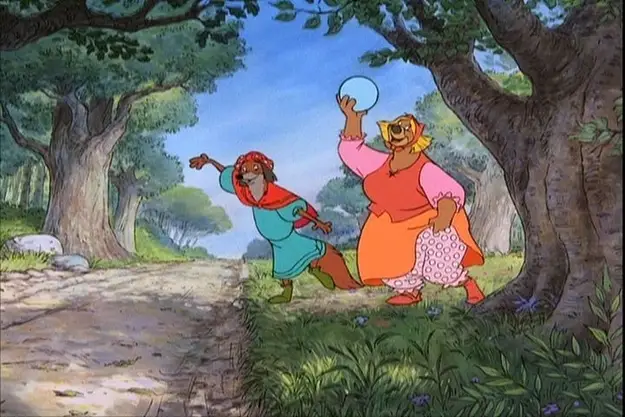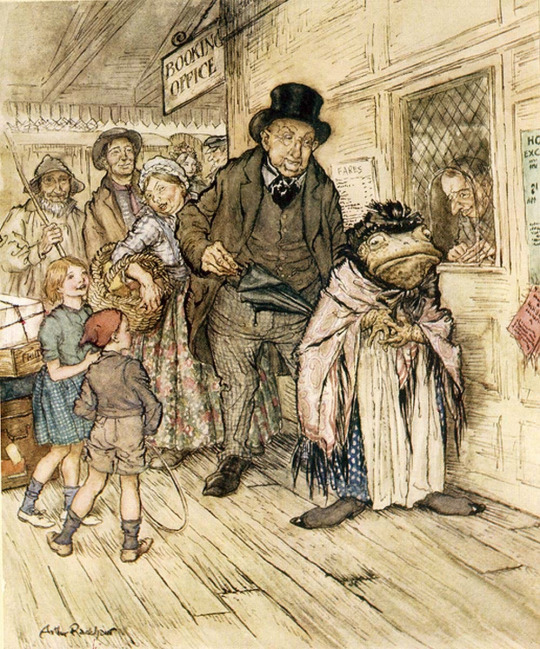Well, we’ve reached Chapter 8 in the re-reading of The Wind in the Willows (I already mentioned it here and here), and Chapter 8 is where we see Toad’s misadventures reaching a peak of misery: the rascal has been put in prison where he laments his bad fate, he gets into the good graces of the gaoler’s daughter, cross-dresses as a washerwoman and daringly escapes on board of a train. There you have it.
Now, as you know I’m not particularly fond of Toad, but there are a couple of interesting features in this chapter and I’d like to address them in comparison with other tales I’m very fond of. So stick with me if you’re fond of washerwomen and cross-dressing heroes.
1. Mrs Tiggy-Winkle, laundresses in the night and other working-class ladies
Washerwomen are a recurring element in Breton’s folklore, particularly as the so-called lavandières de la nuit, laundresses of the night: they’re ghostly women cursed to do their laundry for eternity, who go around scaring the shit out of people in the middle of the night, and variants of these include the Washer at the Ford trope, the Gaelic bean-nighe, ghostly women in Ireland who wash the bloodied skirt of people about to die, oracle figures in Scotland and wish-granters in Wales (if they don’t rip your arms out like a Wookie, that is).
Jean-Édouard “Yan” Dargent painted them in his 1861 work, and I think you get the idea.
Illustrations on the same subject were drawn by a plethora of local artists such as Victor Lemonnier (see here) and Emile Souvestre (see here). There’s a beautiful blog post about them, telling one of the scariest legends, at this address.
When Grahame started writing his story, however, society had already declassified laundry as a job fit for lower-class women. The infamous Magdalene asylums picked this specific job as suitable for their “fallen women”, and not by chance. The way Charles Dickens shows us a washerwoman, in his Christmas Carol, is a good indication of the place they had in society: such a woman steals the blankets and curtains from the mysterious man who died unloved during the vision with the spirit of Christmas Yet To Come.
The most famous washerwoman in children’s literature, however, is quite possibly Beatrix Potter‘s Mrs Tiggy-Winkle in the homonymous tale. Published in October 1905, the story took inspiration from an old Scottish countrywoman Beatrix had met during her childhood, Kitty MacDonald, when the Potters were spending their holidays at Dalguise, Perthshire. Their relationship was close enough for Beatrix to visit her again when she moved back to Scotland, this time in Birnam, aged 27. The woman was 83, at this time, but Beatrix described her as…
…old Katie MacDonald, the Highland washerwoman. She was a tiny body, brown as a berry, beady black eyes and much wrinkled, against an incongruously white frilled mutch. She wore a small plaid crossed over shawl pinned with a silver brooch, a bed jacket, and a full kilted petticoat. She dropped bob curtsies, but she was outspoken and very independent, proud and proper.
If you want to read more about their relationship, I suggest you take a look here. A mutch, as defined by the Scots Language Centre, is a headdress of white linen or muslin, quite similar to a cowl.
The name Mrs Tiggy-winkle, on the other hand, comes from Potter’s pet hedgehog.

Two studies of a hedgehog by Beatrix Potter, preserved at the Victoria & Albert museum.
The main character of the tale is Lucie Carr, modelled after a real-life Lucy, and it’s one of the few stories by Potter in which a child is invited to partake in the animal kingdom and its day-to-day functioning.
As she’s roaming the Little-Town farm in search of three pocket handkerchiefs and a pinafore she lost (again, the pinafore is some sort of apron), little Lucie follows a trail of clothes up a grassy hill, finds a small wooden door and hears someone singing.
Lily-white and clean, oh!
With little frills between, oh!
Smooth and hot – red rusty spot
Never here be seen, oh!
That’s how she learns of Mrs Tiggy-Winkle who lives inside the house, and whom she finds doing the laundry, ironing and, of course, singing.
She found Lucie’s lost clothes, washed them and ironed them. Picking up a big basket of laundry, the two set off to return all the rest of the clothing to animals and birds in the neighbourhood: there’s a pair of yellow socks for Sally Henny-penny, the spotted hen who has been running barefoot since the beginning of the story, there’s a red handkerchief belonging to old Mrs Rabbit which smelled rather nastily of onions, there’s a pair of mittens for Tabby Kitten, dicky shirt-fronts for Tom Titmouse and woolly coats belonging to the little lambs at Skelghyl. It is as if Potter revisited all her previous stories and concocted a character who’s tidying up the animal’s apparel behind the scenes.
Lucie and Mrs Tiggy-Winkle have tea together, and then they set off to return the laundry to each one of these animals. Peter Rabbit and Benjamin Bunny even make guest appearances.
When the two are done, however, a magical thing happens, which is also quite unlike in Potter’s stories.
Lucie scrambled up the stile with the bundle in her hand; and then she turned to say “Good-night,” and to thank the washer-woman.—But what a very odd thing! Mrs. Tiggy-winkle had not waited either for thanks or for the washing bill!
She was running, running, running up the hill—and where was her white frilled cap? and her shawl? and her gown—and her petticoat?
And how small she had grown—and how brown—and covered with prickles!
Why! Mrs. Tiggy-winkle was nothing but a Hedgehog!(Now some people say that little Lucie had been asleep upon the stile—but then how could she have found three clean pocket-handkins and a pinny, pinned with a silver safety-pin?
And besides—I have seen that door into the back of the hill called Cat Bells—and besides I am very well acquainted with dear Mrs. Tiggy-winkle!)
Her vanishing is by far less scary than any story you might read on the washerwomen in the night, but not less supernatural. There seems to be something otherworldly about doing the laundry, especially when it’s bourgeoise authors who write about it.
Sir Frederick Ashton performed in the role of Mrs Tiddy-Winkle during the 1971 Tales of Beatrix Potter with the Royal Ballet, a show that returned around 10 years ago. He was also the choreographer, so he really can’t blame anybody but himself.
Now, Grahame is not as accurate as Potter in his description of the clothes the laundress sells Toad as a device for his escape. They’re a cotton print gown, an apron, a shawl, and a rusty black bonnet with strings that are tied under Toad’s chin. Many illustrators have tried their hand at depicting the scene. David Peterson, who worked on his illustrations for a book published by IDW around 2016, gives us a detailed account of his process in this marvellous blog post.
The most refined depiction of Toad’s disguise is however, in my humble opinion, depicted by Arthur Rackham. The cap, the shawl, the detail of the skirt and even the idea of the sloppy socks used to conceal Toad’s feet are an absolute delight.
2. Cross-dressing heroes
In his book Children’s Literature, Seth Lerer dedicates a whole chapter to Edwardian literature and, by calling it “Pan in the Garden”, a great part of it is dedicated to our Kenneth Grahame. He has something particularly interesting to say about Toad’s disguise, comparing it with contemporary adventure stories like Anthony Hope’s tremendously influential Prisoner of Zenda (1894), Robert L. Stevenson’s Dr Jekyll and Mr Hyde which is all about changing appearances (1886) and Sir Conan Doyle’s Sherlock Holmes stories.
What readers… found so enduring in these works was their concern with costume and impersonation. They make adventure inseparable from dress-up, and Toad’s tale chimes with their details.
And he continues (spoiler alert from the following chapters):
When he comes home from his exploits, he finds Rat and recognizes that “he could lay aside a disguise that was unworthy of his position”. Such a decision llies at the heart of these late Victorian and Edwardian works, for it asks the questions central to the age: What is the nature of the self? How do we dress to reveal, or conceal, our inner being? Will the dark inside come out, regardless of our costume? …Toad’s escapades had been ones of “escapes”, “disguises,” and “subterfuges.” And when Rat finally gets Toad to calm down, he implores him to “go off upstairs at once, and take off that old cotton rag that looks as if it might formerly have belonged to some washerwoman, and clean yourself thoroughly, and put on ome of my clothes, and try and come down looking like a gentleman, if you can.” For Rat, impersonation is a vice. The true gentleman is not a creature of the theatre, but a man of the house.
Now, this angle is tremendously interesting, in my opinion, for we aren’t sure at all Grahame entirely agreed with Rat’s firm position and, if we are, his remark is more classist than specifically referred to the cross-dressing aspect of the whole situation.
As pointed out by Annie Gauger in her paramount Annotated version of the book, Toad’s dress-up has noble roots in literature and bears a strong echo of Falstaff’s misadventures in Shakespeare’s Merry Wives of Windsor, in which the hero is aided by Mistress Page and disguised as her aunt, a woman known as “the fat woman of Brentford”. To disguise the knight, they fetch a gown, a hat or some linen for his head, a muffler, and a handkerchief. Things develop in a way so unheroic that Toad’s escape seems like a chivalrous runaway: even posing as the fat lady, Falstaff is beaten black and blue or, as he put it, in all the colours of the rainbow.
In an early version of the tale, Toad got beaten by one of the guards in a similar fashion, as he bore resentment because the actual washerwoman had mismanaged his laundry. The beating was erased in the final version but oddly replaced with sexual tension where Toad has to undergo all the usual humiliations and catcalls from the guards in order to escape. A weird thing to put in a book for children, I know.
A much nobler predecessor is to be found in Greek epics, and there’s no doubt of an explicit connection between The Wind in the Willows and Homer (as we’ll see in the title of the very last chapter). Geraldine Poss in her “An Epic in Arcadia”, quoted by Gauger, draws an early parallel between Toad and Ulysses, as they both escape with the aid of a woman, but I think the parallel is much more accurate when made between Toad’s unbecoming disguise and what Achilles tries to pull off while trying to avoid leaving for war. Though absent in the canonical Ilyad, the story sees the hero disguising himself as a girl at the court of the king of Skyros, falling in love with one princess Deidamia, and marrying her. Sometimes, she even cross-dresses in return and follows him to war posing as a man. It’s traditionally Odysseus who reveals the trick with his proverbial cunning, hence a bit of bad blood between the two.
Ludovico Ariosto doesn’t fail to pick up gender swapping as a central theme in his Orlando Furioso: when Fiordespina falls in love with Bradamante after seeing her in full armour, a tale left incomplete by Boiardo in his Orlando Innamorato, it is her brother who disguises himself as a woman and snatches the fruit of this passion.
If you think you can dismiss the notion of a cross-dressing hero just because it’s just Greeks being Greeks and Italians being Italians, I’ve got bad news for you: Norse mythology is literally riddled with heroes who dress as women through tribulation or as some part of a trick. Most famously, Thor dresses as a woman in the Þrymskviða poem of the Poetic Edda, posing as no other than Freyja dressed up as a bride. If you’re wondering, it’s of course Loki who convinces him, and dresses up as his bridesmaid. Now tell me it’s a thing you don’t wish to see in the Marvel version.
The notion of men dressing up as women to aid an escape is also a common trope in English ballads: Robin Hood and the Bishop, collected by Francis James Child, sees the titular hero trading clothes and accessories with an old spinner woman; the Duke of Athole is aided by an innkeeper’s daughter and disguised as a baker to save him from women who came for him instead of his love; Robin Brown uses a similar trick to hook up with the king’s daughter, though depending on the version he’s not always lucky.

Being a trickster, Disney’s Robin Hood isn’t a stranger to cross-dressing either. The idea of using a gipsy fortune-teller echoes Jane Eyre (1847), in which Mr Rochester employs that trick to try and extort a love confession from the main character.

















No Comments